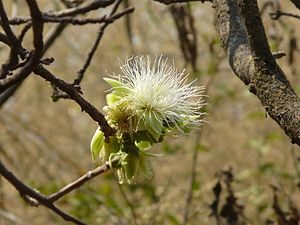Note: This is a project under development. The articles on this wiki are just being initiated and broadly incomplete. You can Help creating new pages.
Careya arborea - Kubhīkaḥ
Kulaµjana consists of dried rhizome of Alpinia galanga. It is a plant grows up to about 2m tall. It is native to eastern Himalayas and southwest India. This plat is belongs to Lecythidaceae family.
Contents
- 1 Uses
- 2 Parts Used
- 3 Chemical Composition
- 4 Common names
- 5 Properties
- 6 Habit
- 7 Identification
- 8 List of Ayurvedic medicine in which the herb is used
- 9 Where to get the saplings
- 10 Mode of Propagation
- 11 Cultivation Details
- 12 Commonly seen growing in areas
- 13 Photo Gallery
- 14 References
- 15 External Links
Uses
Food
Careya arborea can be used in food. Flowers cooked as vegetable and fruits are pickled[1].
Parts Used
Chemical Composition
Seeds contain triterpenoid sapogenols, sterols; leaves contain a triterpene ester, beta-amyrin, hexacosanol, taraxerol, beta-sitosterol, quercetin and taraxeryl acetate.[2]
Common names
| Language | Common name |
|---|---|
| Kannada | Daddala, Gudda, Daddippe |
| Hindi | Kumbhi |
| Malayalam | Pezuntol |
| Tamil | Ayma |
| Telugu | Gadava |
| Marathi | NA |
| Gujarathi | NA |
| Punjabi | NA |
| Kashmiri | NA |
| Sanskrit | Svādupuṣpa, Viṭapī, Sthala Kumbhī |
| English | Cyloneoek |
Properties
Reference: Dravya - Substance, Rasa - Taste, Guna - Qualities, Veerya - Potency, Vipaka - Post-digesion effect, Karma - Pharmacological activity, Prabhava - Therepeutics.
Dravya
Rasa
Kaṭu, Kaṣāya
Guna
Rūkṣa
Veerya
Uṣṇa
Vipaka
Kaṭu
Karma
Kaphahara, Vātahara, Grāhī,
Prabhava
Nutritional components
Careya arborea contains the Following nutritional components like Vitamin-C and E; Calcium, Iron, Magnesium, Phosphorus, Potassium, Sodium etc[1].
Habit
Identification
Leaf
| Kind | Shape | Feature |
|---|---|---|
| Paripinnate | Oblong | Leaf Arrangement is Alternate-spiral |
Flower
| Type | Size | Color and composition | Stamen | More information |
|---|---|---|---|---|
| Unisexual | 2-4cm long | Pink | Flowering throughout the year and In terminal and/or axillary pseudoracemes |
Fruit
| Type | Size | Mass | Appearance | Seeds | More information |
|---|---|---|---|---|---|
| Oblong pod | Thinly septate, pilose, wrinkled | Seeds upto 5 | Fruiting throughout the year |
Other features
List of Ayurvedic medicine in which the herb is used
Where to get the saplings
Mode of Propagation
Cultivation Details
Fresh seeds germinate readily. Prefers a well-drained, sandy or even rocky soil[6]. It is available through March to April[1]
Commonly seen growing in areas
Secondary forest, Slightly seasonal forest, Along forest edges.
Photo Gallery
References
- ↑ 1.0 1.1 1.2 "Forest food for Northern region of Western Ghats" by Dr. Mandar N. Datar and Dr. Anuradha S. Upadhye, Page No.39, Published by Maharashtra Association for the Cultivation of Science (MACS) Agharkar Research Institute, Gopal Ganesh Agarkar Road, Pune
- ↑ Chemical composition
- ↑ Karnataka Aushadhiya Sasyagalu By Dr.Maagadi R Gurudeva, Page no:111
- ↑ [Morphology]
- ↑ Ayurvedic preparations
- ↑ Cultivation details
External Links
- Ayurvedic Herbs known to be helpful to treat Body swellings
- Ayurvedic Herbs known to be helpful to treat Cough
- Ayurvedic Herbs known to be helpful to treat Cold
- Herbs with Fruit used in medicine
- Herbs with Seed used in medicine
- Herbs with Flower used in medicine
- Herbs with common name in Kannada
- Herbs with common name in Hindi
- Herbs with common name in Malayalam
- Herbs with common name in Tamil
- Herbs with common name in Telugu
- Herbs with common name in Sanskrit
- Herbs with common name in English
- Habit - Deciduous tree
- Index of Plants which can be propagated by Seeds
- Herbs that are commonly seen in the region of Secondary forest
- Herbs that are commonly seen in the region of Slightly seasonal forest
- Herbs that are commonly seen in the region of Along forest edges
- Herbs
- Ayurvedic herbs that don't have seed photos
- Lecythidaceae






